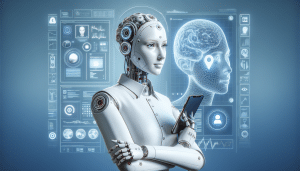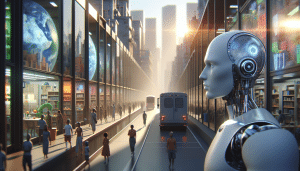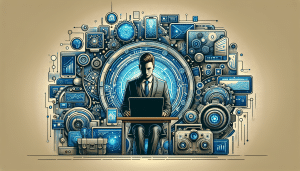AI Powers Everyday Life in Surprising Ways
Oliver Cooper October 17, 2025
Artificial intelligence isn’t just for tech insiders—it shapes experiences, choices, and routines in the modern world. This article explores fascinating applications of AI, the science behind intelligent systems, and how recent breakthroughs influence privacy, jobs, and what’s next in daily life and business.
AI Technology in Daily Life: Beyond the Hype
Artificial intelligence, or AI, quietly powers many aspects of ordinary routines, often in ways most people overlook. Smart assistants on phones can recognize speech, offer personalized recommendations, and even anticipate needs based on past behavior. In streaming platforms, AI is responsible for curating playlists, suggesting movies, and making shopping smarter by analyzing vast amounts of data. This integration signals a significant shift from simple automation to intelligence that adapts and learns over time. Devices such as smart thermostats, robotic vacuum cleaners, and voice-enabled gadgets use interconnected systems that process incoming information rapidly to make real-time decisions, creating seamless and intuitive living spaces. The invisible infrastructures of AI touch health, travel, and social interactions, revealing how deeply embedded this technology is in contemporary life.
AI’s reach is not limited to home gadgets. In transportation, smart navigation systems route traffic efficiently and anticipate hazards on the road, while public safety networks monitor and respond to situations faster than before. Personalized learning engines in schools adapt educational content to individual needs, promoting better outcomes. Financial services deploy AI for fraud detection and guiding customers toward appropriate decisions. Even online search engines continually learn from user input, refining results and accessibility. Behind these applications are complex neural networks and algorithms designed to improve over time as they gather more user data. The result is a dynamic ecosystem where AI not only provides convenience but also becomes integral to societal infrastructure and personal wellbeing.
The subtlety of AI-driven services sometimes leads people to underestimate the impact on daily routines. A quick query to a voice assistant, the smooth management of home heating during a weather change, or fast recommendations for healthy recipes all display the silent work of machine learning at play. These experiences are not simply high-tech luxuries but increasingly necessary supports for modern expectations of speed and accuracy. As AI models become more sophisticated, their presence evolves from support to prediction—offering user-centric solutions by learning preferences and anticipating next steps. This ongoing innovation raises questions about the limits of automation, the scope of human oversight, and new expectations for life in a digitally connected world.
How Machine Learning Shapes Choices and Experiences
Machine learning, a core part of AI, operates on the principle of systems learning from data patterns to improve without explicit programming. This foundational shift allows machines to offer tailored experiences, such as personalized news feeds and targeted online ads. The technology monitors browsing histories, purchase records, and even social media activity to build nuanced user profiles. These profiles drive suggestions—not only making life more convenient but sometimes exposing individuals to new interests and ideas. Financial investment platforms, for instance, leverage machine learning to assess risk tolerances and create customer-specific trading recommendations, demonstrating the depth of AI’s role in nuanced decision-making processes.
Recommendation systems have become one of the most visible faces of machine learning in everyday technology. These tools analyze massive datasets, considering variables from time of use to product feedback, and adjust recommendations in real time. This adaptive strategy makes each interaction feel unique, as users encounter content, products, or information they’re likely to engage with. The result is an intricate web of predictions, some accurate and some less so, that continuously evolve as feedback loops refine the underlying models. These techniques also enable creative tools, from AI-driven art generation to automated music composition, highlighting the intersection of science and creativity.
This deep personalization, however, brings with it a spectrum of experiences and questions about privacy, control, and consent. While many celebrate the convenience of curated digital environments, others question the extent to which machines influence personal choices. Understanding these systems, knowing how to adjust privacy settings, and recognizing the trade-offs between tailored experiences and personal data use are increasingly important. Publicly available guides encourage people to take an active role in managing online identities, balancing enjoyment of benefits with a clear-eyed view of the risks and responsibilities.
The Science Behind Smart Algorithms and Data Privacy
AI effectiveness is driven by sophisticated algorithms designed to identify patterns, predict outcomes, and adapt to new information. Deep learning architectures, modeled loosely on human neural networks, process large volumes of sensory or text data at lightning speed. The advantages are clear: more accurate speech recognition, image identification, and predictive maintenance for complex machinery. However, the science of collecting and integrating data raises essential questions about privacy and ethics. Data streams from fitness trackers, home sensors, and app usage are aggregated—patterns are revealed, sometimes in ways users don’t expect or authorize. Transparency and informed user consent form the backbone of ethical AI deployment, leading organizations to disclose how information is collected and used.
Data privacy concerns are central as AI becomes more embedded in sensitive sectors. Health technologies, for instance, depend on vast datasets to detect medical anomalies and provide wellness feedback, yet must safeguard confidential information. Privacy frameworks, such as GDPR in Europe and various state statutes in the U.S., codify principles around consent, deletion rights, and data minimization. These rules urge companies and researchers to prioritize user security and clarity, often by providing privacy dashboards or customizable options for data sharing. Reports from watchdog groups highlight the importance of regular audits and vulnerability testing for any platform utilizing AI tools.
To foster trust in AI systems, transparency remains a critical component. Open access policies from academic institutions and technology leaders encourage the release of algorithmic details and bias testing methodologies. Educators and technology advocates push for digital literacy, equipping users to detect automated decision-making in daily interactions and take corrective action. This growing demand for openness influences the pace and direction of research, ensuring innovation aligns with user expectations and societal norms. The future of AI will likely depend as much on balancing privacy as it does on advancing raw capability.
AI Advances in Healthcare and Scientific Research
Few areas show the profound potential of artificial intelligence as clearly as healthcare and scientific exploration. Medical imaging analysis, for example, benefits from pattern-detecting algorithms that spot subtle changes invisible to human eyes. AI tools help identify early disease markers, suggest personalized treatment plans, and even forecast outbreak patterns—all with an eye toward increasing accuracy and efficiency. Genomics, a field dedicated to deciphering the genetic code, now leverages machine learning to accelerate discoveries that once took decades. These same technologies are revolutionizing environmental models and drug discovery by processing massive amounts of data to identify meaningful trends and solutions.
Clinical decision support has entered a new era. Systems learn from historical patient data, medical guidelines, and outcomes, enabling tailored recommendations for clinicians. In some settings, AI-assisted diagnostics now rival or surpass traditional methods in conditions like skin cancer detection and retinal disease screening. Hospital management and public health policy also benefit; predictive analytics guide resource allocation, emergency planning, and risk mitigation. These innovations help streamline healthcare delivery and can reduce human error, though experts note the importance of maintaining a human-in-the-loop approach for critical decisions.
Scientific research thrives thanks to AI’s ability to simulate experiments and model complex systems. Whether in climate change studies, biochemical analysis, or astrophysics, intelligent systems can process variables beyond what humans alone can manage. This computational muscle advances understanding and speeds time-to-discovery. Open-source initiatives and collaborative international datasets make breakthroughs more accessible, allowing scientists worldwide to build on shared findings. As AI continues to permeate research methods, dialogue around ethical standards, data stewardship, and equitable access becomes part of the scientific process, shaping the future of discovery.
AI and the Changing World of Work
The transformation of the workplace is one of AI’s most-discussed effects. Intelligent automation tools take on repetitive tasks in industries ranging from manufacturing to accounting, freeing up time for higher-level thinking and analysis. Jobs such as logistics routing, document verification, and supply chain monitoring see efficiency gains thanks to machine vision and data mining. At the same time, new job categories emerge—AI ethicists, trainers for machine learning models, and algorithm fairness reviewers are in growing demand as organizations seek to comply with regulations and build trustworthy products. Preparing for this evolving landscape means developing both technical skills and adaptive mindsets.
While the opportunities increase, disruption is part of the equation. Sectors like retail, finance, and transportation adapt to automation by retraining existing employees and defining new forms of collaboration between humans and machines. Some roles become obsolete, but others transform, requiring creativity, emotional intelligence, and digital literacy. Education and training programs, both from universities and technology companies, offer resources for workers to gain new competencies—sometimes at no cost. Policies to broaden access and minimize workforce dislocation include investment in digital education, ensuring more equitable transition as technology reshapes the employment landscape.
Debates about job security, wage polarization, and AI’s impact on global labor markets are active and nuanced. Experts stress that responsible introduction of AI in the workplace is not only about efficiency, but also equity and opportunity. Guidelines for ethical use, transparency in algorithmic decision-making, and ongoing workforce training are key aspects of responsible innovation. By paying attention to the experiences of those most affected, societies can balance progress with inclusion, ensuring AI advancement leads to prosperity rather than unintended challenges.
Preparing for What’s Next in AI Innovation
As artificial intelligence becomes more essential, preparing for emerging trends is vital for everyone. Brain-inspired computing, quantum algorithms, and large language models hint at coming revolutions. Some of these advances focus on making AI more energy efficient, robust against adversarial attacks, or aligned with human values. Interdisciplinary research teams are central to breakthroughs, combining expertise in computer science, neuroscience, and engineering. Open access to academic findings and collaborative coding platforms builds an environment where new discoveries spread quickly and responsibly.
Ethics and governance are at the forefront of AI’s next phase. Initiatives from nonprofit and governmental organizations provide frameworks for safe deployment and fair use of automated decision-making. Principles such as explainability, fairness, and accountability are gaining traction as standards. Regulatory bodies in several countries issue guidelines for testing, monitoring, and intervention when AI affects critical services. The challenge is to ensure these frameworks are agile enough to keep pace with technology, encouraging innovation while safeguarding social trust and public good.
Education, public dialogue, and iterative policy updates form the foundation for a future where AI serves human needs rather than the other way around. As access to intelligent systems grows, so too does the need for responsible stewardship across business, education, and civic life. Engagement from a diverse set of voices helps define priorities, spotlight challenges, and inspire breakthroughs aligned with core values. By staying informed and proactive, individuals and organizations can help shape an AI-powered world that amplifies positive change and meets complex modern demands.
References
1. Future of Privacy Forum. (n.d.). Understanding Facial Recognition and Privacy. Retrieved from https://fpf.org/understanding-facial-recognition-and-privacy/
2. European Commission. (n.d.). Artificial Intelligence. Retrieved from https://digital-strategy.ec.europa.eu/en/policies/artificial-intelligence
3. National Institutes of Health. (n.d.). AI Applications in Biomedical Research. Retrieved from https://datascience.nih.gov/artificial-intelligence
4. U.S. Department of Education. (n.d.). Artificial Intelligence and the Future of Teaching and Learning. Retrieved from https://tech.ed.gov/artificial-intelligence/
5. Brookings Institution. (2022). Artificial Intelligence and the Future of Work. Retrieved from https://www.brookings.edu/articles/artificial-intelligence-and-the-future-of-work/
6. Organization for Economic Co-operation and Development. (n.d.). AI Principles. Retrieved from https://oecd.ai/en/dashboards/ai-principles







